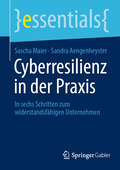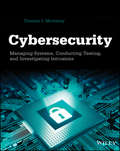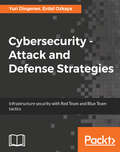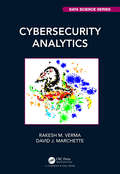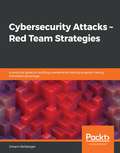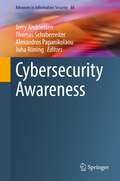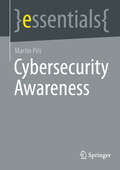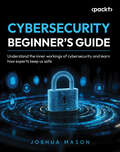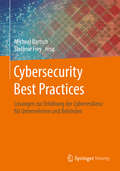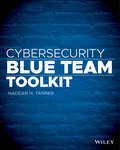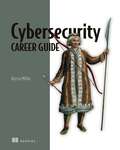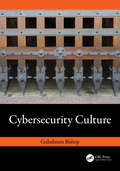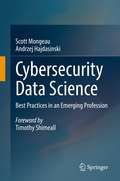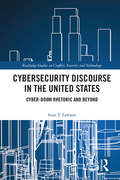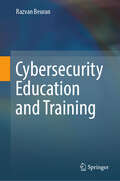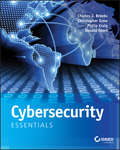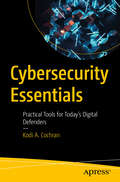- Table View
- List View
Cyberresilienz in der Praxis: In sechs Schritten zum widerstandsfähigen Unternehmen (essentials)
by Sandra Aengenheyster Sascha MaierDas Essential bietet einen praxisnahen Leitfaden für Unternehmen, die ihre Cyberresilienz systematisch aufbauen wollen. In sechs Schritten werden zentrale Aufgaben wie Risikoanalyse, Maßnahmenplanung, Einhaltung von Anforderungen, Einbindung von Beteiligten, Fortschrittskontrolle und langfristige Verankerung behandelt. Ziel ist es, technische und organisatorische Schutzmaßnahmen nachvollziehbar zu strukturieren und die Widerstandsfähigkeit gegenüber Cyberangriffen zu stärken. Das Buch richtet sich an IT-Verantwortliche, angehende Informationssicherheitsbeauftragte und Entscheider:innen im Mittelstand, die eine tragfähige Grundlage für den Umgang mit digitalen Bedrohungen schaffen wollen.
Cybersecurity
by Thomas J. MowbrayA must-have, hands-on guide for working in the cybersecurity profession Cybersecurity involves preventative methods to protect information from attacks. It requires a thorough understanding of potential threats, such as viruses and other malicious code, as well as system vulnerability and security architecture. This essential book addresses cybersecurity strategies that include identity management, risk management, and incident management, and also serves as a detailed guide for anyone looking to enter the security profession. Doubling as the text for a cybersecurity course, it is also a useful reference for cybersecurity testing, IT test/development, and system/network administration. Covers everything from basic network administration security skills through advanced command line scripting, tool customization, and log analysis skills Dives deeper into such intense topics as wireshark/tcpdump filtering, Google hacks, Windows/Linux scripting, Metasploit command line, and tool customizations Delves into network administration for Windows, Linux, and VMware Examines penetration testing, cyber investigations, firewall configuration, and security tool customization Shares techniques for cybersecurity testing, planning, and reporting Cybersecurity: Managing Systems, Conducting Testing, and Investigating Intrusions is a comprehensive and authoritative look at the critical topic of cybersecurity from start to finish.
Cybersecurity (The MIT Press Essential Knowledge series)
by Duane C. WilsonAn accessible guide to cybersecurity for the everyday user, covering cryptography and public key infrastructure, malware, blockchain, and other topics.It seems that everything we touch is connected to the internet, from mobile phones and wearable technology to home appliances and cyber assistants. The more connected our computer systems, the more exposed they are to cyber attacks--attempts to steal data, corrupt software, disrupt operations, and even physically damage hardware and network infrastructures. In this volume of the MIT Press Essential Knowledge series, cybersecurity expert Duane Wilson offers an accessible guide to cybersecurity issues for everyday users, describing risks associated with internet use, modern methods of defense against cyber attacks, and general principles for safer internet use.Wilson describes the principles that underlie all cybesecurity defense: confidentiality, integrity, availability, authentication, authorization, and non-repudiation (validating the source of information). He explains that confidentiality is accomplished by cryptography; examines the different layers of defense; analyzes cyber risks, threats, and vulnerabilities; and breaks down the cyber kill chain and the many forms of malware. He reviews some online applications of cybersecurity, including end-to-end security protection, secure ecommerce transactions, smart devices with built-in protections, and blockchain technology. Finally, Wilson considers the future of cybersecurity, discussing the continuing evolution of cyber defenses as well as research that may alter the overall threat landscape.
Cybersecurity - Attack and Defense Strategies: Infrastructure security with Red Team and Blue Team tactics
by Yuri Diogenes Dr. Erdal OzkayaPublisher's Note: This is an outdated edition published in 2018. Cyberthreats and the strategies to counter them have evolved exponentially in the months since this book was first published. A new edition, updated for 2020 with the very latest in cybersecurity threats and defense strategies, is now available.Enhance your organization's secure posture by improving your attack and defence strategiesKey FeaturesGain a clear understanding of the attack methods, and patterns to recognize abnormal behavior within your organization with Blue Team tacticsLearn to unique techniques to gather exploitation intelligence, identify risk and demonstrate impact with Red Team and Blue Team strategiesA practical guide that will give you hands-on experience to mitigate risks and prevent attackers from infiltrating your systemBook DescriptionThe book will start talking about the security posture before moving to Red Team tactics, where you will learn the basic syntax for the Windows and Linux tools that are commonly used to perform the necessary operations. You will also gain hands-on experience of using new Red Team techniques with powerful tools such as python and PowerShell, which will enable you to discover vulnerabilities in your system and how to exploit them. Moving on, you will learn how a system is usually compromised by adversaries, and how they hack user's identity, and the various tools used by the Red Team to find vulnerabilities in a system.In the next section, you will learn about the defense strategies followed by the Blue Team to enhance the overall security of a system. You will also learn about an in-depth strategy to ensure that there are security controls in each network layer, and how you can carry out the recovery process of a compromised system. Finally, you will learn how to create a vulnerability management strategy and the different techniques for manual log analysis.What you will learnLearn the importance of having a solid foundation for your security postureUnderstand the attack strategy using cyber security kill chainLearn how to enhance your defense strategy by improving your security policies, hardening your network, implementing active sensors, and leveraging threat intelligenceLearn how to perform an incident investigationGet an in-depth understanding of the recovery processUnderstand continuous security monitoring and how to implement a vulnerability management strategyLearn how to perform log analysis to identify suspicious activitiesWho this book is forThis book aims at IT professional who want to venture the IT security domain. IT pentester, Security consultants, and ethical hackers will also find this course useful. Prior knowledge of penetration testing would be beneficial.
Cybersecurity 2050: Protecting Humanity in a Hyper-Connected World
by Soorena MeratThis book explores the critical intersection of human behavior, cybersecurity, and the transformative potential of quantum technologies. It delves into the vulnerabilities and resilience of human intelligence in the face of cyber threats, examining how cognitive biases, social dynamics, and mental health can be exploited in the digital age.Cybersecurity 2050: Protecting Humanity in a Hyper-Connected World explores the cutting-edge applications of quantum computing in cybersecurity, discussing the efficiency of quantum security algorithms on Earth and over space communications such as those needed to inhabit Mars. The challenges and opportunities of human life on extraterrestrial worlds, such as Mars, will further shape the evolution of human intelligence. The isolated and confined environment of a Martian habitat, coupled with the reliance on advanced technologies for survival, will demand new forms of adaptability, resilience, and social cooperation. The author addresses the imminent revolution in cybersecurity regulations and transforms the attention of the bright minds of businesses and policymakers for the challenges and opportunities of quantum advancements. This book attempts to bridge the gap between social intelligence and cybersecurity, offering a holistic and nuanced understanding of these interconnected domains. Through real-world case studies, the author provides practical insights and strategies for adapting to the evolving technological landscape and building a more secure digital future.This book is intended for futuristic minds, computer engineers, policymakers, or regulatory experts interested in the implications of the revolution of human intelligence on cybersecurity laws and regulations. It will be of interest to cybersecurity professionals and researchers looking for a historic and comprehensive understanding of the evolving landscape, including social intelligence, quantum computing, and algorithm design.
Cybersecurity All-in-One For Dummies
by Kevin Beaver Joseph Steinberg Ira Winkler Ted CoombsOver 700 pages of insight into all things cybersecurity Cybersecurity All-in-One For Dummies covers a lot of ground in the world of keeping computer systems safe from those who want to break in. This book offers a one-stop resource on cybersecurity basics, personal security, business security, cloud security, security testing, and security awareness. Filled with content to help with both personal and business cybersecurity needs, this book shows you how to lock down your computers, devices, and systems—and explains why doing so is more important now than ever. Dig in for info on what kind of risks are out there, how to protect a variety of devices, strategies for testing your security, securing cloud data, and steps for creating an awareness program in an organization. Explore the basics of cybersecurity at home and in business Learn how to secure your devices, data, and cloud-based assets Test your security to find holes and vulnerabilities before hackers do Create a culture of cybersecurity throughout an entire organizationThis For Dummies All-in-One is a stellar reference for business owners and IT support pros who need a guide to making smart security choices. Any tech user with concerns about privacy and protection will also love this comprehensive guide.
Cybersecurity Analytics (Chapman & Hall/CRC Data Science Series)
by Rakesh M. Verma David J. MarchetteCybersecurity Analytics is for the cybersecurity student and professional who wants to learn data science techniques critical for tackling cybersecurity challenges, and for the data science student and professional who wants to learn about cybersecurity adaptations. Trying to build a malware detector, a phishing email detector, or just interested in finding patterns in your datasets? This book can let you do it on your own. Numerous examples and datasets links are included so that the reader can "learn by doing." Anyone with a basic college-level calculus course and some probability knowledge can easily understand most of the material. The book includes chapters containing: unsupervised learning, semi-supervised learning, supervised learning, text mining, natural language processing, and more. It also includes background on security, statistics, and linear algebra. The website for the book contains a listing of datasets, updates, and other resources for serious practitioners.
Cybersecurity Attacks – Red Team Strategies: A practical guide to building a penetration testing program having homefield advantage
by Johann RehbergerDevelop your red team skills by learning essential foundational tactics, techniques, and procedures, and boost the overall security posture of your organization by leveraging the homefield advantage Key Features Build, manage, and measure an offensive red team program Leverage the homefield advantage to stay ahead of your adversaries Understand core adversarial tactics and techniques, and protect pentesters and pentesting assets Book Description It's now more important than ever for organizations to be ready to detect and respond to security events and breaches. Preventive measures alone are not enough for dealing with adversaries. A well-rounded prevention, detection, and response program is required. This book will guide you through the stages of building a red team program, including strategies and homefield advantage opportunities to boost security. The book starts by guiding you through establishing, managing, and measuring a red team program, including effective ways for sharing results and findings to raise awareness. Gradually, you'll learn about progressive operations such as cryptocurrency mining, focused privacy testing, targeting telemetry, and even blue team tooling. Later, you'll discover knowledge graphs and how to build them, then become well-versed with basic to advanced techniques related to hunting for credentials, and learn to automate Microsoft Office and browsers to your advantage. Finally, you'll get to grips with protecting assets using decoys, auditing, and alerting with examples for major operating systems. By the end of this book, you'll have learned how to build, manage, and measure a red team program effectively and be well-versed with the fundamental operational techniques required to enhance your existing skills. What you will learn Understand the risks associated with security breaches Implement strategies for building an effective penetration testing team Map out the homefield using knowledge graphs Hunt credentials using indexing and other practical techniques Gain blue team tooling insights to enhance your red team skills Communicate results and influence decision makers with appropriate data Who this book is for This is one of the few detailed cybersecurity books for penetration testers, cybersecurity analysts, security leaders and strategists, as well as red team members and chief information security officers (CISOs) looking to secure their organizations from adversaries. The program management part of this book will also be useful for beginners in the cybersecurity domain. To get the most out of this book, some penetration testing experience, and software engineering and debugging skills are necessary.
Cybersecurity Awareness (Advances in Information Security #88)
by Juha Röning Jerry Andriessen Thomas Schaberreiter Alexandros PapanikolaouThis contributed volume tells the story of the establishment of a cybersecurity awareness framework for organizations, and how it was piloted in two public sector municipal contexts. It presents a clear picture of cybersecurity issues in municipalities and proposes a socio-technical solution for creating cybersecurity awareness, how to build the solution and what the impact is on the municipal contexts. The 9 chapters for this book also provide information regarding the design, the deployment and the evaluation of the technology.This book builds on the success of the European Horizon 2020 research and innovation project CS-AWARE. The research proposes the first cybersecurity situational awareness solution for local public administrations based on an analysis of the context, provides automatic incident detection and visualization, and enables information exchange with relevant national and EU level authorities involved in legislation and network security.Cybersecurity is one of the most challenging security problems for commercial companies, NGOs, governmental institutions as well as individuals. Reaching beyond the technology focused boundaries of classical information technology (IT) security, cybersecurity includes organizational and behavioral aspects of IT systems and that needs to comply to legal and regulatory framework for cybersecurity. While large corporations might have the resources to follow those developments and bring their IT infrastructure and services in line with the requirements, the burden for smaller organizations like local public administrations will be substantial and the required resources might not be available. New and innovative solutions that would help local public administration to ease the burden of being in line with cybersecurity requirements are needed.This book targets researchers working in cybersecurity, computer scientists, social scientists and advanced level students studying computer science and other related disciplines. Cybersecurity professionals as well as professionals working in local government contexts, including policy makers, communication experts and system administrators will also benefit from this book.
Cybersecurity Awareness (essentials)
by Martin PilsIn this essential, Martin Pils unfolds a clear vision for effective security awareness programs aimed at strengthening the human element in cyber defense. The book is rich in practical examples and advice, offering strategies for implementation and providing valuable recommendations for turning employees into vigilant sentinels of information security. With additional materials and hands-on examples, this book is an indispensable resource for designing awareness campaigns that combine knowledge with enjoyment. A concluding checklist serves as a precise guide for practical implementation in daily business.
Cybersecurity Awareness Among Students and Faculty
by Abbas MoallemIn modern times, all individuals need to be knowledgeable about cybersecurity. They must have practical skills and abilities to protect themselves in cyberspace. What is the level of awareness among college students and faculty, who represent the most technologically active portion of the population in any society? According to the Federal Trade Commission’s 2016 Consumer Sentinel Network report, 19 percent of identity theft complaints came from people under the age of 29. About 74,400 young adults fell victim to identity theft in 2016. This book reports the results of several studies that investigate student and faculty awareness and attitudes toward cybersecurity and the resulting risks. It proposes a plan of action that can help 26,000 higher education institutions worldwide with over 207 million college students, create security policies and educational programs that improve security awareness and protection. Features Offers an understanding of the state of privacy awareness Includes the state of identity theft awareness Covers mobile phone protection Discusses ransomware protection Discloses a plan of action to improve security awareness
Cybersecurity Beginner's Guide: Understand the inner workings of cybersecurity and learn how experts keep us safe
by Joshua MasonUnlock cybersecurity secrets and develop a hacker's mindset while building the high-demand skills used by elite hackers and defenders Get With Your Book: PDF Copy, AI Assistant, and Next-Gen Reader FreeKey FeaturesGain an insider's view of cybersecurity roles and the real work they do every dayMake informed career decisions with clear, practical insights into whether cybersecurity is right for youBuild essential skills that keep you safe online, regardless of your career pathBook DescriptionIn today’s increasingly connected world, cybersecurity touches every aspect of our lives, yet it remains a mystery to most. This beginner’s guide pulls back the curtain on how cybersecurity really works, revealing what professionals do to keep us safe. Learn how cyber threats emerge, how experts counter them, and what you can do to protect yourself online. Perfect for business leaders, tech enthusiasts, and anyone curious about digital security, this book delivers insider knowledge without the jargon. This edition also explores cybersecurity careers, AI/ML in cybersecurity, and essential skills that apply in both personal and professional contexts. Air Force pilot turned cybersecurity leader Joshua Mason shares hard-won insights from his unique journey, drawing on years of training teams and advising organizations worldwide. He walks you through the tools and strategies used by professionals, showing how expert practices translate into real-world protection. With up-to-date information of the latest threats and defenses, this cybersecurity book is both an informative read and a practical guide to staying secure in the digital age.What you will learnMaster the fundamentals of cybersecurity and why it's crucialGet acquainted with common cyber threats and how they are counteredDiscover how cybersecurity impacts everyday life and businessExplore cybersecurity tools and techniques used by professionalsSee cybersecurity in action through real-world cyber defense examplesNavigate Generative AI confidently and develop awareness of its security implications and opportunitiesUnderstand how people and technology work together to protect digital assetsImplement simple steps to strengthen your personal online securityWho this book is forThis book is for curious minds who want to decode cybersecurity without the technical jargon. Whether you're a business leader making security decisions, a student exploring career options, a tech enthusiast seeking insider knowledge, or simply someone who wants to stay safe online, this book bridges the gap between complex concepts and practical understanding. No technical background needed—just an interest in learning how to stay safe in an increasingly digital environment.
Cybersecurity Best Practices: Lösungen zur Erhöhung der Cyberresilienz für Unternehmen und Behörden
by Michael Bartsch Stefanie FreyDas Thema Cybersecurity ist so aktuell wie nie, denn im Cyberspace lassen sich nur schwer Grenzen in Bezug auf den Zugang zu Informationen, Daten und Redefreiheit setzen. Kriminelle nutzen die Lücken oft zu ihrem Vorteil aus. Die Vielzahl der IT-Systeme, ihre unterschiedlichen Nutzungsarten und ihre Innovations- und Lebenszyklen haben zu hohen Sicherheitsrisiken für Unternehmen und staatliche Einrichtungen geführt. Diese Risiken werden sich auch langfristig nicht so einfach aus der Welt schaffen lassen. Daher müssen Institutionen Strategien und Lösungen zu ihrem Selbstschutz entwickeln. Dieses Buch beschreibt Lösungsansätze und Best Practices aus den unterschiedlichsten Bereichen, die nachweislich zu einer höheren Resilienz gegenüber Cyberangriffen führen. Weltweit renommierte IT-Sicherheitsexperten berichten in 40 Beiträgen, wie sich staatliche Institutionen, unter anderem das Militär (Cyber Defence), Behörden, internationale Organisationen und Unternehmen besser gegen Cyberangriffe schützen und nachhaltige Schutzstrategien entwickeln können. Die Autoren widmen sich den Gründen und Zielen, die ihren jeweiligen Strategien zugrunde liegen, sie berichten, wie Unternehmen auf konkrete Cyberattacken reagiert haben und wie einzelne staatliche Institutionen angesichts nationaler Cyberstrategien agieren. In weiteren Kapiteln zeigen Wissenschaftler auf, was bei der Abwehr von Cyber-Attacken bereits heute möglich ist, welche Entwicklungen in Arbeit sind und wie diese in Zukunft eingesetzt werden können, um die Cyber-Sicherheit zu erhöhen. Im letzten Kapitel berichten Hersteller, Anwenderunternehmen und Dienstleister welche Best Practices sie in ihren Unternehmen eingeführt haben und wie andere Unternehmen ihrem Beispiel folgen können. Das Buch richtet sich an IT-Verantwortliche und -Sicherheitsbeauftragte in Unternehmen und anderen Organisationen, aber auch an Studierende in den verschiedenen IT-Studiengängen.
Cybersecurity Blue Team Strategies: Uncover the secrets of blue teams to combat cyber threats in your organization
by Kunal Sehgal Nikolaos ThymianisBuild a blue team for efficient cyber threat management in your organizationKey FeaturesExplore blue team operations and understand how to detect, prevent, and respond to threatsDive deep into the intricacies of risk assessment and threat managementLearn about governance, compliance, regulations, and other best practices for blue team implementationBook DescriptionWe've reached a point where all organizational data is connected through some network. With advancements and connectivity comes ever-evolving cyber threats - compromising sensitive data and access to vulnerable systems. Cybersecurity Blue Team Strategies is a comprehensive guide that will help you extend your cybersecurity knowledge and teach you to implement blue teams in your organization from scratch. Through the course of this book, you'll learn defensive cybersecurity measures while thinking from an attacker's perspective. With this book, you'll be able to test and assess the effectiveness of your organization's cybersecurity posture. No matter the medium your organization has chosen- cloud, on-premises, or hybrid, this book will provide an in-depth understanding of how cyber attackers can penetrate your systems and gain access to sensitive information. Beginning with a brief overview of the importance of a blue team, you'll learn important techniques and best practices a cybersecurity operator or a blue team practitioner should be aware of. By understanding tools, processes, and operations, you'll be equipped with evolving solutions and strategies to overcome cybersecurity challenges and successfully manage cyber threats to avoid adversaries. By the end of this book, you'll have enough exposure to blue team operations and be able to successfully set up a blue team in your organization.What you will learnUnderstand blue team operations and its role in safeguarding businessesExplore everyday blue team functions and tools used by themBecome acquainted with risk assessment and management from a blue team perspectiveDiscover the making of effective defense strategies and their operationsFind out what makes a good governance programBecome familiar with preventive and detective controls for minimizing riskWho this book is forThis book is for cybersecurity professionals involved in defending an organization's systems and assets against attacks. Penetration testers, cybersecurity analysts, security leaders, security strategists, and blue team members will find this book helpful. Chief Information Security Officers (CISOs) looking at securing their organizations from adversaries will also benefit from this book. To get the most out of this book, basic knowledge of IT security is recommended.
Cybersecurity Blue Team Toolkit
by Nadean H. TannerA practical handbook to cybersecurity for both tech and non-tech professionals As reports of major data breaches fill the headlines, it has become impossible for any business, large or small, to ignore the importance of cybersecurity. Most books on the subject, however, are either too specialized for the non-technical professional or too general for positions in the IT trenches. Thanks to author Nadean Tanner’s wide array of experience from teaching at a University to working for the Department of Defense, the Cybersecurity Blue Team Toolkit strikes the perfect balance of substantive and accessible, making it equally useful to those in IT or management positions across a variety of industries. This handy guide takes a simple and strategic look at best practices and tools available to both cybersecurity management and hands-on professionals, whether they be new to the field or looking to expand their expertise. Tanner gives comprehensive coverage to such crucial topics as security assessment and configuration, strategies for protection and defense, offensive measures, and remediation while aligning the concept with the right tool using the CIS Controls version 7 as a guide. Readers will learn why and how to use fundamental open source and free tools such as ping, tracert, PuTTY, pathping, sysinternals, NMAP, OpenVAS, Nexpose Community, OSSEC, Hamachi, InSSIDer, Nexpose Community, Wireshark, Solarwinds Kiwi Syslog Server, Metasploit, Burp, Clonezilla and many more. Up-to-date and practical cybersecurity instruction, applicable to both management and technical positions • Straightforward explanations of the theory behind cybersecurity best practices • Designed to be an easily navigated tool for daily use • Includes training appendix on Linux, how to build a virtual lab and glossary of key terms The Cybersecurity Blue Team Toolkit is an excellent resource for anyone working in digital policy as well as IT security professionals, technical analysts, program managers, and Chief Information and Technology Officers. This is one handbook that won’t gather dust on the shelf, but remain a valuable reference at any career level, from student to executive.
Cybersecurity Career Guide
by Alyssa MillerKickstart a career in cybersecurity by adapting your existing technical and non-technical skills. Author Alyssa Miller has spent fifteen years in cybersecurity leadership and talent development, and shares her unique perspective in this revealing industry guide.In Cybersecurity Career Guide you will learn: Self-analysis exercises to find your unique capabilities and help you excel in cybersecurity How to adapt your existing skills to fit a cybersecurity role Succeed at job searches, applications, and interviews to receive valuable offers Ways to leverage professional networking and mentoring for success and career growth Building a personal brand and strategy to stand out from other applicants Overcoming imposter syndrome and other personal roadblocks Cybersecurity Career Guide unlocks your pathway to becoming a great security practitioner. You&’ll learn how to reliably enter the security field and quickly grow into your new career, following clear, practical advice that&’s based on research and interviews with hundreds of hiring managers. Practical self-analysis exercises identify gaps in your resume, what makes you valuable to an employer, and what you want out of your career in cyber. You&’ll assess the benefits of all major professional qualifications, and get practical advice on relationship building with mentors. About the technology Do you want a rewarding job in cybersecurity? Start here! This book highlights the full range of exciting security careers and shows you exactly how to find the role that&’s perfect for you. You&’ll go through all the steps—from building the right skills to acing the interview. Author and infosec expert Alyssa Miller shares insights from fifteen years in cybersecurity that will help you begin your new career with confidence. About the book Cybersecurity Career Guide shows you how to turn your existing technical skills into an awesome career in information security. In this practical guide, you&’ll explore popular cybersecurity jobs, from penetration testing to running a Security Operations Center. Actionable advice, self-analysis exercises, and concrete techniques for building skills in your chosen career path ensure you&’re always taking concrete steps towards getting hired. What's inside Succeed at job searches, applications, and interviews Building your professional networking and finding mentors Developing your personal brand Overcoming imposter syndrome and other roadblocks About the reader For readers with general technical skills who want a job in cybersecurity. About the author Alyssa Miller has fifteen years of experience in the cybersecurity industry, including penetration testing, executive leadership, and talent development. Table of Contents PART 1 EXPLORING CYBERSECURITY CAREERS 1 This thing we call cybersecurity 2 The cybersecurity career landscape 3 Help wanted, skills in a hot market PART 2 PREPARING FOR AND MASTERING YOUR JOB SEARCH 4 Taking the less traveled path 5 Addressing your capabilities gap 6 Resumes, applications, and interviews PART 3 BUILDING FOR LONG-TERM SUCCESS 7 The power of networking and mentorship 8 The threat of impostor syndrome 9 Achieving success
Cybersecurity Career Master Plan: Proven techniques and effective tips to help you advance in your cybersecurity career
by Kim Nguyen Jonathan Helmus Dr. Gerald Auger Jaclyn “Jax” Scott Heath "The AdamsGet started with cybersecurity and progress with the help of expert tips to get certified, find a job, and moreKey FeaturesLearn how to follow your desired career path that results in a well-paid, rewarding job in cybersecurityExplore expert tips relating to career paths and certification optionsAccess informative content from a panel of experienced cybersecurity expertsBook DescriptionCybersecurity is an emerging career trend and will continue to become increasingly important. Despite the lucrative pay and significant career growth opportunities, many people are unsure of how to get started.This book is designed by leading industry experts to help you enter the world of cybersecurity with confidence, covering everything from gaining the right certification to tips and tools for finding your first job. The book starts by helping you gain a foundational understanding of cybersecurity, covering cyber law, cyber policy, and frameworks. Next, you'll focus on how to choose the career field best suited to you from options such as security operations, penetration testing, and risk analysis. The book also guides you through the different certification options as well as the pros and cons of a formal college education versus formal certificate courses. Later, you'll discover the importance of defining and understanding your brand. Finally, you'll get up to speed with different career paths and learning opportunities.By the end of this cyber book, you will have gained the knowledge you need to clearly define your career path and develop goals relating to career progression.What you will learnGain an understanding of cybersecurity essentials, including the different frameworks and laws, and specialtiesFind out how to land your first job in the cybersecurity industryUnderstand the difference between college education and certificate coursesBuild goals and timelines to encourage a work/life balance while delivering value in your jobUnderstand the different types of cybersecurity jobs available and what it means to be entry-levelBuild affordable, practical labs to develop your technical skillsDiscover how to set goals and maintain momentum after landing your first cybersecurity jobWho this book is forThis book is for college graduates, military veterans transitioning from active service, individuals looking to make a mid-career switch, and aspiring IT professionals. Anyone who considers cybersecurity as a potential career field but feels intimidated, overwhelmed, or unsure of where to get started will also find this book useful.
Cybersecurity Career Master Plan: Proven techniques and effective tips to help you advance in your cybersecurity career
by Kim Nguyen Jonathan Helmus Dr. Gerald Auger Jaclyn “Jax” ScottStart your Cybersecurity career with expert advice on how to get certified, find your first job, and progress Purchase of the print or Kindle book includes a free eBook in PDF formatKey FeaturesLearn how to follow your desired career path that results in a well-paid, rewarding job in cybersecurityExplore expert tips relating to career growth and certification optionsAccess informative content from a panel of experienced cybersecurity expertsBook DescriptionCybersecurity is an emerging career trend and will continue to become increasingly important. Despite the lucrative pay and significant career growth opportunities, many people are unsure of how to get started. This book is designed by leading industry experts to help you enter the world of cybersecurity with confidence, covering everything from gaining the right certification to tips and tools for finding your first job. The book starts by helping you gain a foundational understanding of cybersecurity, covering cyber law, cyber policy, and frameworks. Next, you’ll focus on how to choose the career field best suited to you from options such as security operations, penetration testing, and risk analysis. The book also guides you through the different certification options as well as the pros and cons of a formal college education versus formal certificate courses. Later, you’ll discover the importance of defining and understanding your brand. Finally, you’ll get up to speed with different career paths and learning opportunities. By the end of this cyber book, you will have gained the knowledge you need to clearly define your career path and develop goals relating to career progression.What you will learnGain an understanding of cybersecurity essentials, including the different frameworks and laws, and specialtiesFind out how to land your first job in the cybersecurity industryUnderstand the difference between college education and certificate coursesBuild goals and timelines to encourage a work/life balance while delivering value in your jobUnderstand the different types of cybersecurity jobs available and what it means to be entry-levelBuild affordable, practical labs to develop your technical skillsDiscover how to set goals and maintain momentum after landing your first cybersecurity jobWho this book is forThis book is for college graduates, military veterans transitioning from active service, individuals looking to make a mid-career switch, and aspiring IT professionals. Anyone who considers cybersecurity as a potential career field but feels intimidated, overwhelmed, or unsure of where to get started will also find this book useful. No experience or cybersecurity knowledge is needed to get started.
Cybersecurity Challenges in the Age of AI, Space Communications and Cyborgs: Proceedings of the 15th International Conference on Global Security, Safety and Sustainability, London, October 2023 (Advanced Sciences and Technologies for Security Applications)
by Hamid JahankhaniThis book provides an opportunity for researchers, scientists, government officials, strategist and operators and maintainers of large, complex and advanced systems and infrastructure to update their knowledge with the state of best practice in the challenging domains while networking with the leading representatives, researchers and solution providers. The advancement of Artificial Intelligence (AI), coupled with the prolificacy of the Internet of Things (IoT) devices are creating smart societies that are interconnected. Space exploration and satellite, drone and UAV technology have travelled a long way in recent years and some may debate that we are in the midst of a revolution; in terms of development and the increasing number of these devices being launched. But with this revolutionary progress, it presents itself with new challenges in terms of governance. The ethical implications of connecting the physical and digital worlds, and presenting the reality of a truly interconnected society, presents the realization of the concept of smart societies in reality.Drawing on 14 years of successful events on Information security, digital forensics and cybercrime, the 15th ICGS3-23 conference aims to provide attendees with an information-packed agenda with representatives from across the industry and the globe. The challenges of complexity, rapid pace of change and risk/opportunity issues associated with modern products, systems, special events and infrastructures. In an era of unprecedented volatile, political and economic environment across the world, computer based systems face ever more increasing challenges, disputes and responsibilities and while the Internet has created a global platform for the exchange of ideas, goods and services, however, it has also created boundless opportunities for cyber-crime.This book presents new materials and contributes to knowledge through the technological advances that are being made across artificial intelligence (AI), machine learning, blockchain and quantum computing. These technologies driven by a digital revolution are expected to be disruptive and provide major digital transformation in the way societies operate today. As a result, these advances provide social and economic benefits, but, also, provide new challenges that security industry need to raise their game to combat them.
Cybersecurity Culture
by Gulsebnem BishopThe culture of cybersecurity is a complex subject. We can look at cybersecurity culture from different perspectives. We can look at it from the organizational point of view or from within the culture. Each organization has a culture. Attitudes toward security have different manifestations in each organizational culture. We also see how the cybersecurity phenomenon unfolds in other cultures is complicated. Each culture reacts differently to this phenomenon. This book will emphasize both aspects of cybersecurity. From the organizational point of view, this book will emphasize the importance of the culture of cybersecurity in organizations, what it is, and how it can be achieved. This includes the human aspects of security, approach and awareness, and how we can design systems that promote the culture of security. It is also important to emphasize the psychological aspects briefly because it is a big part of the human approach.From a cultural point of view, this book will emphasize how different cultures approach the culture of cybersecurity. The cultural complexity of cybersecurity will be noted by giving examples from different cultures. How leadership in different cultures approach security and how different cultures approach change. Case studies from each culture will be presented to demonstrate different approaches to implementing security and training practices. Overall, the textbook will be a good resource for cybersecurity students who want to understand how cultures and organizations within those cultures approach security. It will also provide a good resource for instructors who would like to develop courses on cybersecurity culture.Finally, this book will be an introductory resource for anyone interested in cybersecurity's organizational or cultural aspects.
Cybersecurity Data Science: Best Practices in an Emerging Profession
by Scott Mongeau Andrzej HajdasinskiThis book encompasses a systematic exploration of Cybersecurity Data Science (CSDS) as an emerging profession, focusing on current versus idealized practice. This book also analyzes challenges facing the emerging CSDS profession, diagnoses key gaps, and prescribes treatments to facilitate advancement. Grounded in the management of information systems (MIS) discipline, insights derive from literature analysis and interviews with 50 global CSDS practitioners. CSDS as a diagnostic process grounded in the scientific method is emphasized throughout Cybersecurity Data Science (CSDS) is a rapidly evolving discipline which applies data science methods to cybersecurity challenges. CSDS reflects the rising interest in applying data-focused statistical, analytical, and machine learning-driven methods to address growing security gaps. This book offers a systematic assessment of the developing domain. Advocacy is provided to strengthen professional rigor and best practices in the emerging CSDS profession. This book will be of interest to a range of professionals associated with cybersecurity and data science, spanning practitioner, commercial, public sector, and academic domains. Best practices framed will be of interest to CSDS practitioners, security professionals, risk management stewards, and institutional stakeholders. Organizational and industry perspectives will be of interest to cybersecurity analysts, managers, planners, strategists, and regulators. Research professionals and academics are presented with a systematic analysis of the CSDS field, including an overview of the state of the art, a structured evaluation of key challenges, recommended best practices, and an extensive bibliography.
Cybersecurity Discourse in the United States: Cyber-Doom Rhetoric and Beyond (Routledge Studies in Conflict, Security and Technology)
by Sean T. LawsonThis book examines the role of cyber-doom rhetoric in the U.S. cybersecurity debate.For more than two decades, fear of "cyber-doom" scenarios—i.e. cyberattacks against critical infrastructure resulting in catastrophic physical, social, and economic impacts—has been a persistent feature of the U.S. cybersecurity debate. This is despite the fact that no cyberattack has come close to realizing such impacts. This book argues that such scenarios are part of a broader rhetoric of cyber-doom within the U.S. cybersecurity debate, and takes a multidisciplinary approach that draws on research in history, sociology, communication, psychology, and political science. It identifies a number of variations of cyber-doom rhetoric, then places them into a larger historical context, assesses how realistic the fears expressed in such rhetoric are, and finally draws out the policy implications of relying on these fears to structure our response to cybersecurity challenges. The United States faces very real cybersecurity challenges that are, nonetheless, much less dramatic than what is implied in the rhetoric. This book argues that relying on cyber-doom rhetoric to frame our thinking about such threats is counterproductive, and encourages us to develop ways of thinking and speaking about cybersecurity beyond cyber-doom.This book will be of much interest to students of cybersecurity, foreign policy, public administration, national security, and international relations in general.
Cybersecurity Education and Training
by Razvan BeuranThis book provides a comprehensive overview on cybersecurity education and training methodologies. The book uses a combination of theoretical and practical elements to address both the abstract and concrete aspects of the discussed concepts. The book is structured into two parts. The first part focuses mainly on technical cybersecurity training approaches. Following a general outline of cybersecurity education and training, technical cybersecurity training and the three types of training activities (attack training, forensics training, and defense training) are discussed in detail. The second part of the book describes the main characteristics of cybersecurity training platforms, which are the systems used to conduct the technical cybersecurity training activities. This part includes a wide-ranging analysis of actual cybersecurity training platforms, namely Capture The Flag (CTF) systems and cyber ranges that are currently being used worldwide, and a detailed study of an open-source cybersecurity training platform, CyTrONE. A cybersecurity training platform capability assessment methodology that makes it possible for organizations that want to deploy or develop training platforms to objectively evaluate them is also introduced. This book is addressed first to cybersecurity education and training practitioners and professionals, both in the academia and industry, who will gain knowledge about how to organize and conduct meaningful and effective cybersecurity training activities. In addition, researchers and postgraduate students will gain insights into the state-of-the-art research in the field of cybersecurity training so that they can broaden their research area and find new research topics.
Cybersecurity Essentials
by Philip Craig Charles J. Brooks Christopher Grow Donald ShortAn accessible introduction to cybersecurity concepts and practices Cybersecurity Essentials provides a comprehensive introduction to the field, with expert coverage of essential topics required for entry-level cybersecurity certifications. An effective defense consists of four distinct challenges: securing the infrastructure, securing devices, securing local networks, and securing the perimeter. Overcoming these challenges requires a detailed understanding of the concepts and practices within each realm. This book covers each challenge individually for greater depth of information, with real-world scenarios that show what vulnerabilities look like in everyday computing scenarios. Each part concludes with a summary of key concepts, review questions, and hands-on exercises, allowing you to test your understanding while exercising your new critical skills. Cybersecurity jobs range from basic configuration to advanced systems analysis and defense assessment. This book provides the foundational information you need to understand the basics of the field, identify your place within it, and start down the security certification path. Learn security and surveillance fundamentals Secure and protect remote access and devices Understand network topologies, protocols, and strategies Identify threats and mount an effective defense Cybersecurity Essentials gives you the building blocks for an entry level security certification and provides a foundation of cybersecurity knowledge
Cybersecurity Essentials: Practical Tools for Today's Digital Defenders
by Kodi A. CochranEmbarking on the journey through this comprehensive cybersecurity guide promises readers a transformative experience, equipping them with invaluable insights, practical skills, and a profound understanding of the intricate world of digital defense. Whether you're an industry professional seeking to enhance your expertise or a newcomer eager to navigate the cybersecurity landscape, this guide serves as your trusted companion. Expect to gain a profound grasp of foundational concepts, illustrated through real-world examples and practical applications. Dive into the logical flow of CompTIA Pentest+ objectives and (ISC)2 SSCP & CCSP, aligning your learning with industry standards. Beyond theory, this guide empowers you with actionable tips and emerging trends, ensuring your knowledge remains current in the dynamic realm of cybersecurity. As you progress through each chapter, anticipate a hands-on exploration of offensive and defensive security, offering a pathway to certification from a vendor-neutral perspective. Ultimately, this guide is designed to not only enhance your cybersecurity skill set but to foster a holistic approach, making you adept at navigating the evolving cyber landscape with confidence and expertise. What You Will Learn Study a step-by-step guide to conducting vulnerability assessments Follow post-exploitation techniques for maintaining access Understand essential network security concepts, including firewalls, intrusion detection systems, and other network security measures Review secure coding practices and the importance of web application security Explore mobile and IoT security best practices Review tools and practices for securing cloud environments Discover tips for recognizing and mitigating social engineering threats Who This Book Is For Anyone interested in cybersecurity: recent graduates, IT professionals transitioning into security, veterans, and those who are self taught. One of the largest motivating factors is that there are several certifications—this book will greatly improve the reader's chance of obtaining.
